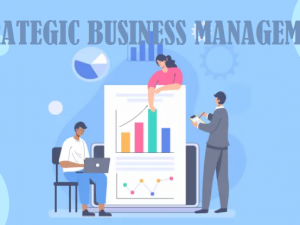Description
Strategic Management Project
The purpose of the strategic management project is to apply the concepts and techniques learnt in the module to the analysis of real-world situations or problems, and to critically evaluate different approaches to addressing managerial problems.
Context
At the managerial level, strategic organisational failures are due to a combination of failures in one or more of the 4Cs – Communication, Collaboration, Coordination, and Control.
Your task is to identify a major area of weakness in a unit of your organisation (not the whole organisation). This can be either in your own department or unit, or your boss has asked you to look at another part of a business, as in internal consultant.
The task has to be organisation design related and cannot be to do with corporate strategy, strategic planning, change management nor generic issues such as falling performance, falling sales etc. The lack of focus is likely to result in a failed task.
The unit of analysis MUST be for a unit of the company you work for. (If your company is a large one, then focus on a strategic business unit or department. The structure will be aimed at your designation level ie supervisor, team leaders, unit head, head of strategic business unit, CEO etc. Frame the issue at your level so that you are familiar with the issues. For example if you are a supervisor it would be inappropriate for you to look at International diversification but this might be something for the CEO. Also this would be about corporate strategy and not part of your remit anyway for this assignment.
If you are not employed currently, use your previous employer. Exceptionally if this not possible, (permission from the module leader will need to be sought) select a well-known local company and use the same criteria. Delve down to the lowest level commensurate with your designation.
The organisation must give signed consent to the project as you will need detailed information/data.
Under no circumstances are you allowed to choose multinationals about which you have no connection. Doing so will result in a failed assignment.
Your remit, in the form of a strategic management project will be to examine what the problem(s) is/are (you must provide evidence of this via board or team meetings, internal records etc), identify the likely causes and the reasons for it (in light of your understanding from this module) and propose a new design, approach (solution) that would overcome that strategic failure. You then justify and explain how your design will overcome the failure and put in place appropriate monitoring system to evaluate outcomes.
Also note, this module and assessment is DIFFERENT from change management and transformation literature which relates to “how” change should be undertaken, what is good practice, what to avoid, role and types of leadership ie the psychology of change. What students are looking in this module is the physiology and sociology of organisations ie design for strategic effectiveness. If you turn this into a change management assignment you will likely fail.
The project is to be undertaken in a number of formative phases, culminating in a final written report.
In phase 1 you will write proposal for your tutor to set the parameters and scope of the project. You will discuss this with your classmates in seminars and get feedback. In this phase you will state what the organisation is and what your designation is, what the strategic failure is. Your tutor will record all this information in a table and supply it to the module leader for approval. 2-3 pages maximum.
Phase 2 will be a critical literature review. Your task will be to review research from a range of scholarly articles that relate to organisational structure design issues you are addressing. This is an opportunity to strengthen the project rigour with further theoretical insights. The core text book and supplied articles will form the backbone of the literature review but other strategy literature can supplement this too. This informs your thinking on and about the restructure before, during and after the redesign.
You will have learnt from the research methods classes in the module 7MG001, a literature review is a critical discussion of the published information on your topic area. It is also a critical, evaluative synthesis, showing the relationships between various writings and how they relate to your own work. A literature review is not a simple summary of a series of articles. A good literature review will look at the research that has been done and synthesise or pull together those elements that are similar or most pertinent to the themes you have chosen. The alignment of literature to issues looked will form a key part of the grading for this part.
Phase 3 will be the analysis/redesign. First you will give a pen portrait of the business unit under investigation (only write one paragraph on the company itself) by analysing your chosen unit’s internal structures and its external environment using some of the frameworks studied that you consider most relevant to your particular situation e.g. Daft’s structural dimensions, Daft’s contingency framework, Porter’s five forces model or any other model, such SWOT etc. Don’t do these just for the sake of it. The tools need to be relevant to the issues explored.
If the issue is/are wholly internal for example it would not make sense to use porter’s 5 forces because that is about the external industry analysis. If the issues arise due to forces in the external environment or is boundary spanning than the 5 forces may be suitable or perhaps stakeholder analysis or any other similar tool but each tool needs to be pertinent to the issues of the restructure. Grading will reflect if you have seriously thought about the tools you are using.
All the tools you used must go in the appendices and NOT in the main body. Only take a paragraph or two of what each tool is showing.
Your tutor will ask you to present your findings at interim points during the seminar sessions (details will vary depending on iteration and delivery format. The presentations will not be part of the assessment.
Phase 4 will the final Project Report.
The final report should take the form of a maximum 4000 word business report to the organisation’s management team. A business report is a functional piece of writing usually written to communicate recommendations with the appropriate rationale, illustrations and evidence.
Your report should be written in standard business English that favours ease of comprehension. In general, your sentences and paragraphs will be shorter compared to academic English. It is also acceptable to use a limited number of bullet points in your report.
Use the literature review as well as the theoretical foundations given in the core text and additional readings to strengthen your arguments and move beyond subjective opinions. You are also encouraged to support your arguments and analyses with limited amount of visuals, such as charts and diagrams.
NOTE: Visual must be used very sparingly. Do not include data, company charts, blank images of analytical tools or irrelevant junk. It is unlikely visuals will exceed more than 5-6 and most of these will be in the appendices. You will be heavily penalised if you turn a report that is more of an art show than a report.
Business reports do not have a set number of sections, nevertheless guidelines are provided as below. Make sure you do clearly delineate and label your sections with appropriate headings. As a guide, some sections that most reports tend to include are Executive Summary, Introduction, Findings, Recommendations and Conclusion. Use the Business Report Help Sheet from University of Melbourne provided for you under resources.
Advice: Make it concise, to the point and convincing. Try to write with a specific audience in mind, and try as best as you can to generate a genuine buy-in from stakeholders. Suggested structure as follows:
Executive summary
1 Introduction
1 1.introduction to the company
1.2 Business Case (remember to include evidence for the need to redesign)
2 Literature review (this informs your thinking on and about the restructure before, during and after
3 Analysis/Restructure
Design and restructure
Monitoring
4 Conclusions





